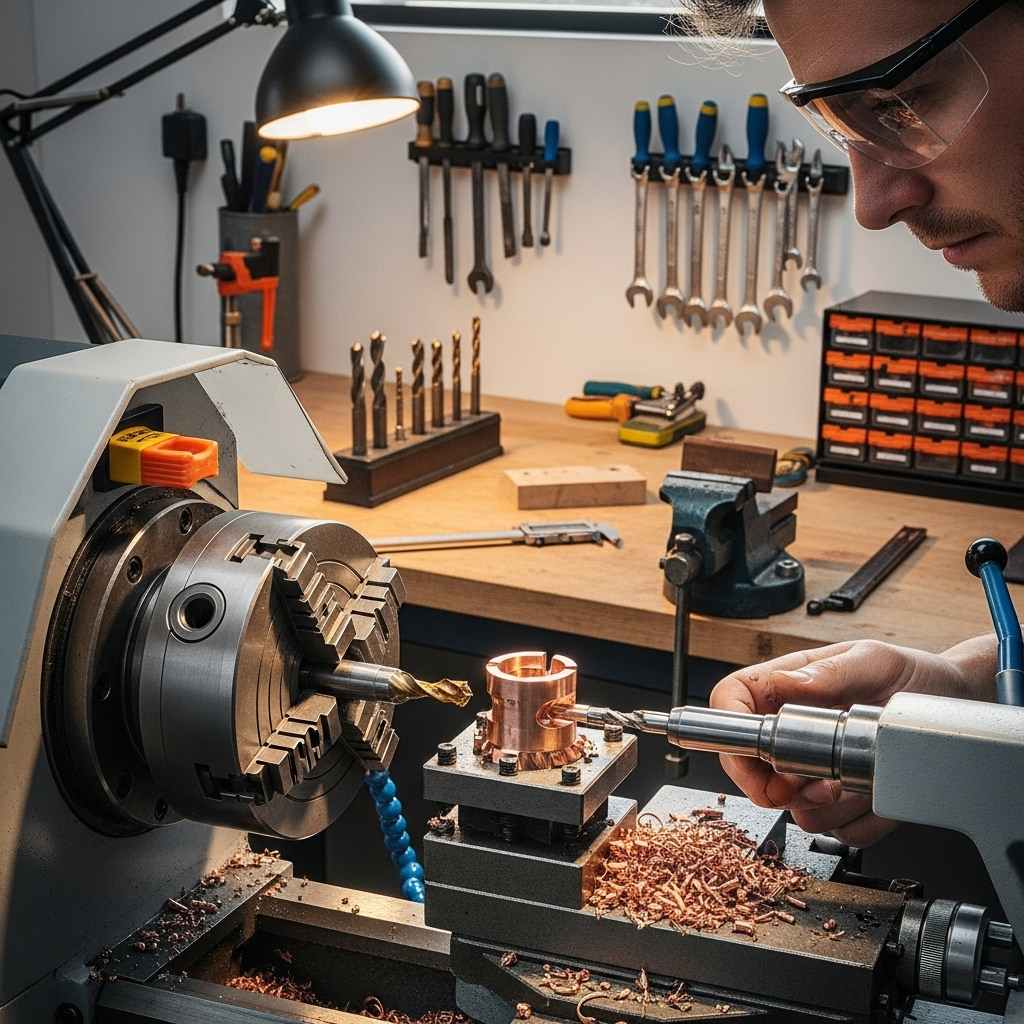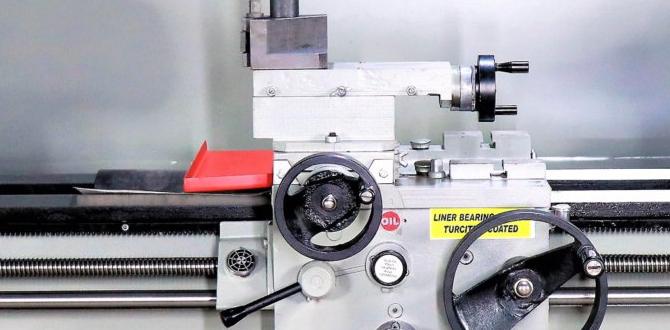For precise copper machining with tight tolerances, a high-quality 1/4-inch carbide stub-length end mill with a 1/4-inch shank is your go-to tool for clean cuts and excellent detail. Choosing the right one ensures smooth operations and superior results for your projects.
Hey there, fellow makers and tinkerers! Daniel Bates here, your guide from Lathe Hub, where we make the world of machining accessible and exciting. Today, we’re diving into a very specific, yet incredibly important, tool for those of you working with copper: the 1/4-inch carbide stub-length end mill with a 1/4-inch shank. You might be thinking, “Copper? End mills? What’s the big deal?” Well, when you need precision, especially for intricate designs or parts that need to fit together perfectly, selecting the right cutter is crucial. It’s like picking the right paint brush for a delicate detail; the wrong one can mess everything up. This guide is all about demystifying this specialized tool, bringing clarity to its use, and ensuring you get those beautiful, tight-tolerance results every single time. Stick with me, and we’ll have you cutting copper like a pro in no time!
Understanding the Carbide End Mill: Your Precision Cutting Companion
Let’s break down what we’re talking about. When we say “end mill,” we’re referring to a type of milling cutter. It’s a bit like a drill bit, but instead of just plunging down, it can also cut sideways. This makes them incredibly versatile for creating slots, pockets, and complex shapes on a milling machine. Now, let’s get specific:
- Carbide: This is the material the end mill is made from. Tungsten carbide is incredibly hard and durable, meaning it can cut through tough materials like metals (including copper!) much more effectively and for longer periods than high-speed steel (HSS) bits. It also holds its sharpness better, which is vital for tight tolerances.
- 1/4 Inch: This refers to the cutting diameter of the end mill. So, it will create a cut that is 1/4 inch wide.
- 1/4 Inch Shank: This is the part of the end mill that gets held by your milling machine’s collet or tool holder. A common shank size like 1/4 inch means it will fit in most standard collet systems.
- Stub Length: This is a key feature. A stub length end mill is shorter than a standard end mill. This shorter flute length (the part with the cutting edges) makes it much more rigid. For tight tolerance work, especially in softer metals like copper, rigidity is king. Less flex in the tool means more accurate cuts and less chance of chatter (vibrations that degrade the cut surface).
- For Copper: While carbide end mills are versatile, copper presents its own set of machining challenges. It’s a relatively soft and gummy metal. The right end mill geometry, coating (or lack thereof), and cutting parameters are essential to prevent the copper from sticking to the flutes and causing issues.
- Tight Tolerance: This is the goal – achieving very precise dimensions. This means the part you cut needs to be exactly the size and shape you want it, with very little room for error. This is where the rigidity of a stub-length end mill and the hardness of carbide really shine.
So, when we combine all these elements, we get a tool specifically designed for high-precision machining of copper and similar materials. It’s built for accuracy and efficiency.
Why This Specific End Mill Matters for Copper

Copper is a fantastic material to work with for many applications, from artistic creations to electrical components. However, it has a tendency to be “gummy.” This means it can deform rather than cleanly break away as a cutting tool passes through it. If the wrong tool or settings are used, the copper can build up on the cutting edges of the end mill, leading to:
- Poor surface finish
- Inaccurate dimensions
- Tool breakage
- Damage to your workpiece
The stub length of the end mill is crucial here. A longer end mill has more “reach,” but it also has more potential to flex, especially under the cutting forces. For tight tolerance work, minimizing this flex is paramount. A shorter, stubbier end mill is inherently more rigid. It resists bending and vibration, allowing for a cleaner cut and better dimensional accuracy. This rigidity is exactly what you need to achieve those critical, near-perfect dimensions in copper.
Furthermore, carbide is a superior choice for copper compared to High-Speed Steel (HSS) for several reasons:
- Hardness: Carbide remains hard at higher temperatures generated by machining. Copper can be prone to work hardening if machined too aggressively, and carbide’s heat resistance helps manage this.
- Edge Retention: Carbide holds a sharp edge for much longer than HSS, which is vital when you can’t afford any deviation from your desired shape.
- Chip Clearance: While some carbide end mills have specific geometries for sticky materials, the overall hardness helps maintain a sharp edge that can shear the material rather than drag it.
Key Features to Look For
When you go shopping for this specialized end mill, keep an eye out for these specific features:
Flute Count
For machining softer, “gummy” metals like copper, fewer flutes are often better. This is because each flute needs to clear away chips. With fewer flutes, you get larger chip spaces (gullets), which helps prevent the copper from packing up and clogging the tool. For copper, you’ll often find 2-flute or 3-flute end mills work very well.
- 2-Flute: Generally offers the best chip clearance, making it ideal for softer, gummy materials like copper and aluminum. It can also be run at higher feeds and speeds.
- 3-Flute: Offers a good balance between chip clearance and cutting smoothness. It can provide a slightly better surface finish than a 2-flute mill.
- 4-Flute and up: Usually better suited for harder steels or materials where chatter is less of a concern and a smoother finish is prioritized over chip evacuation.
For tight tolerance copper work, a 2-flute end mill is often the first choice due to its superior chip evacuation capabilities, which directly impacts the quality of the cut and the ability to maintain precision.
Coating
Many end mills come with coatings to improve performance. For copper, you might find a few options:
- Uncoated: A plain, polished carbide end mill can work very well for copper. The smooth surface helps prevent material buildup.
- ZrN (Zirconium Nitride): This is a golden-colored coating that offers good lubricity and wear resistance. It’s excellent for non-ferrous metals like copper and aluminum, helping to reduce friction and material adhesion.
- TiAlN (Titanium Aluminum Nitride) or AlTiN (Aluminum Titanium Nitride): These are common for harder metals and high-temperature applications. While effective, they might be overkill or even slightly abrasive for pure copper compared to an uncoated or ZrN option. For copper, you want something that promotes material flow and reduces sticking.
For tight tolerance work on copper, an uncoated, high-polish carbide end mill or one with a ZrN coating is often recommended to keep the flutes clean and the cut precise.
End Mill Type
We’ve already touched on “stub length,” but it’s worth reiterating. Other types include:
- Standard Length: Offer more reach, but less rigidity.
- Extra Long: Even more reach, significantly less rigid—not for tight tolerance work.
- Ball Nose: The tip is rounded, used for creating 3D contours and fillets.
- Square End: The tip is flat, used for creating sharp corners and pockets.
For your specific need of 1/4 inch diameter with a 1/4 inch shank for tight tolerance copper work, you are most likely looking for a 1/4 inch stub length square end mill. If you need to create rounded internal corners, a ball nose end mill of the same dimensions would be the choice.
Choosing the Right Settings: Feeds and Speeds

This is where practice truly meets theory. Getting the right “feeds and speeds” is critical for any machining operation, but it’s especially important when aiming for tight tolerances in copper. There’s no single magic number—it depends on your specific machine, your end mill, and the exact alloy of copper you’re using. However, we can provide some excellent starting points and principles.
Surface Speed (SFM or SMM)
Surface speed refers to how fast the cutting edge of the tool is moving through the material. For carbide end mills in copper, a good starting range is typically between 300-600 surface feet per minute (SFM). Let’s convert that to metric for wider applicability:
- 1 foot ≈ 0.3048 meters
- SFM to SMM: Multiply SFM by 0.3048
- So, 300 SFM ≈ 91.44 meters per minute (m/min)
- And 600 SFM ≈ 182.88 meters per minute (m/min)
A general guideline for carbide on copper is around 150 SMM (approx. 500 SFM).
Spindle Speed (RPM)
Your spindle speed (how fast your milling machine’s motor spins) is directly related to the surface speed and the diameter of your tool. The formula to calculate spindle speed (RPM) is:
RPM = (SFM 3.28) / Diameter (inches)
Or in metric:
RPM = (SMM 1000) / (π Diameter (mm))
Let’s calculate for our 1/4 inch (0.25 inch) end mill:
Using 500 SFM as a target example:
RPM = (500 SFM 3.28) / 0.25 inches = 6560 RPM
So, a spindle speed around 6000-7000 RPM is a good starting point.
Feed Rate (IPM or MPM)
The feed rate is how fast the tool advances into or across the material. This is often expressed as inches per minute (IPM) or meters per minute (MPM), or sometimes as “chip load” (the thickness of the chip each cutting edge removes).
For copper and a 2-flute carbide end mill, a typical chip load might be between 0.001 to 0.003 inches per tooth (ipt).
Let’s calculate the feed rate (F) in IPM:
F (IPM) = Chip Load (ipt) Number of Flutes RPM
Using a chip load of 0.0015 ipt and our calculated 6560 RPM:
F (IPM) = 0.0015 ipt 2 flutes 6560 RPM = 19.68 IPM
So, a feed rate of around 20 IPM is a reasonable starting point. You might need to adjust this based on how the cut feels and sounds.
Plunge Rate
When plunging the end mill directly into the material (like starting a pocket), you need to use a slower feed rate to avoid bogging down the machine or breaking the tool. A good rule of thumb is to use about 25-50% of your radial feed rate for plunging.
Factors Affecting Your Settings:
- Machine Rigidity: A very sturdy, beefy machine can handle faster feeds and deeper cuts than a lighter hobbyist machine.
- Machine Power: Ensure your spindle motor has enough power to maintain speed under load.
- Copper Alloy: Different copper alloys have slightly different hardness and machinability.
- Tool Sharpness and Condition: A dull or chipped tool will require slower speeds and feeds.
- Depth of Cut (DOC): For tight tolerances, you’ll often take lighter cuts. A general guideline is to keep the radial depth of cut (how far the tool moves sideways) to about 50% of the tool diameter. For axial depth of cut (how deep it cuts down), you can often go deeper, perhaps up to 1x the tool diameter, but lighter is better for precision.
- Coolant/Lubricant: Using a cutting fluid or lubricant is highly recommended for copper. It helps cool the tool, lubricates the cut, and aids in chip evacuation, preventing buildup. For copper, a light oil or a specific copper lubricant is ideal.
Always start conservatively! It’s much better to start with slower speeds and feeds and gradually increase them if the cut is clean and the machine is handling it well, rather than starting too fast and risking tool breakage or a bad cut.
Performing the Machining Operation: Step-by-Step
Let’s walk through how you’d use your 1/4-inch stub-length carbide end mill to machine copper to tight tolerances.
1. Preparation is Key
- Secure Your Workpiece: Ensure your copper is firmly held in a vise or on the milling machine table. Use soft jaws or protect the surface if it’s an aesthetic piece. Misalignment or movement during the cut is a primary cause of inaccuracy.
- Mount the End Mill: Insert the 1/4-inch stub-length end mill into a clean collet. Tighten the collet securely in your milling machine’s spindle. Ensure the runout (wobble) is minimal – a tramming gauge can help check this.
- Apply Lubricant: Have your cutting fluid or lubricant ready. You’ll want to apply it at the point of the cut as machining begins.
- Set Z-Zero: Carefully determine your zero point for the Z-axis. Use an edge finder or a touch-off plate. For critical dimensions, a tool setter can provide higher accuracy.
2. Setting Up Your Machining Program (or Manual Controls)
- Input Feeds and Speeds: Enter your calculated spindle speed (RPM) and feed rate (IPM) into your CNC controller or set your manual machine accordingly. Remember our conservative starting points: ~6500 RPM, ~20 IPM feed.
- Define Depth of Cut: Set your desired depth of cut for the operation. For tight tolerances, take lighter passes. For a pocket, start with maybe 1/8 inch (0.125 inches) or even less.
3. The Cutting Process
- Engage the Spindle: Start the spindle to your set RPM.
- Apply Lubricant: Begin applying lubricant to the area where the cut will occur.
- Initiate the Feed: Begin feeding the tool into the material.
- Leading into the Cut: If you’re milling a slot or pocket, engage the feed in a way that directs the cutting forces away from the rigid jaw of your vise (climb milling, if your machine can handle it, is often preferred for finish, but conventional milling can be safer for learning). Feed slowly and smoothly.
- Plunge cuts: If you need to plunge, reduce your feed rate significantly (e.g., 10 IPM or less) and ensure good chip clearance.
- Monitor the Cut: Listen to the sound of the machine. A smooth, consistent hum is good. Any chattering, digging, or squealing indicates a problem – stop and reassess your settings or tool. Watch for chip buildup; if it looks like the copper is sticking to the end mill, you might need more lubricant, a slower feed, or a different chip load.
- Clear Chips: Periodically, you may need to retract the tool to clear chips, especially if working in a deep pocket. Compressed air can help blow chips away, but be careful not to blow them into other parts of your machine.
- Take Multiple Passes: For tight tolerances, it’s always best practice to take a “roughing” pass that removes most of the material, and then a final “finishing” pass that takes off a very light amount of material (e.g., 0.005 to 0.010 inches). This final pass refines the dimensions and surface finish.
4. Finishing Touches
- Retract and Inspect: Once your final pass is complete, retract the tool clear of the workpiece. Turn off the spindle and carefully inspect your part for accuracy, finish, and any signs of tool wear or damage.
- Deburr: Use a deburring tool or a small file to gently remove any sharp edges that may have formed during machining for safety and a clean finish.
<










